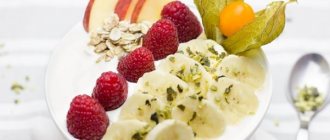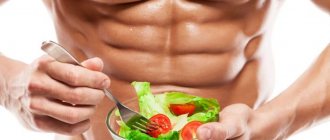According to the World Health Organization for 2021, 4 out of 10 adults in the world are overweight, which makes this problem extremely urgent. To solve this problem, nutritionists prescribe diets that take into account the individual condition of the patient, his age, chronic pathologies and much more. Specialized diets for patients with cardiovascular diseases also have a positive effect on the patient’s weight. The diet and set of products in such diets are ideal for losing weight.
Heart diet
Various cardiac diets are medically called cardiotrophic nutrition. This means that such a diet:
- first of all, it reduces the symptoms and slows down the progression of cardiac pathologies in sick people;
- secondly, it significantly reduces the risk of cardiovascular diseases in healthy people.
Since the cardiovascular system is one of the most important in the body, the beneficial effect of the new diet on it has a dramatic improvement in the general health of patients. Another advantage of this diet is getting rid of swelling in the legs due to a low-hydration diet.
Most often, the heart diet is understood as two types of menus - the Karel diet and Table No. 10 from Soviet nutritionists.
They both have the same goals, but go about it in slightly different ways. The fundamental difference between them is only in the food system - the products underlying the diets are almost identical.
Cholesterol is a substance produced by the body for the normal functioning of metabolic processes and the proper synthesis of hormones. When it increases, therapists recommend a hypocholesterol diet. Read more in the article: “low cholesterol diet for lowering cholesterol.”
It should be remembered that both of these diets were developed for patients with certain diagnoses, and not for simple weight loss. Therefore, you must use them at home without a doctor’s prescription carefully, listening to your own well-being.
Sample menu and general recommendations
The question of what to eat in case of heart failure must be approached competently, because diet alone cannot become the basis of therapeutic nutrition. In addition, different diets are used for different degrees of the disease.
Thus, the well-known diet 10 is a salt-free diet for heart failure. But as the patient’s condition improves, he is given relief in the form of 3-5 g of salt, and later he is completely transferred to the general table. Table No. 10 is complete, containing fiber, vitamins and minerals in sufficient quantities. Food is processed in the usual way, and to improve its taste, instead of table salt, lemon (citric acid), vinegar, boiled and then fried onions, jam, cinnamon, and sugar are added.
For more severe forms of heart failure, a more strict diet is used - table No. 10A, which includes: 50 g of proteins, 70 g of fats, 300-350 g of carbohydrates, 1-1.5 g of salt and up to 0.8 liters of free liquid. The total calorie content of foods should be 2500-2800 calories. The bread is also given salt-free. Food should be taken 6-7 times a day. All dishes in this diet are made chopped or pureed.
In case of ascites and too extensive edema, the doctor may recommend fasting days or a modified Karelian diet. The optimal diet in this case is a fruit and berry diet, for example, eating 1.5 kg of apples per day.
Fasting days are held once a week, but they are contraindicated for weak and exhausted patients.
After the patient’s condition improves (disappearance of shortness of breath and swelling), he is transferred from table No. 10a back to table No. 10.
Karelian diet
The diet was created in 1865 specifically for people with poor circulation or other blood diseases. However, only 150 years later it became popular as a diet for weight loss - after all, only in the last decade has excess weight become a serious problem in developed countries.
The basis of this diet is dairy products with the addition of fruits and several other items that have a beneficial effect on blood circulation and the general well-being of patients.
With this diet, the acid-base balance in the body is corrected, and patients feel much better.
The diet consists of 4 phases, during which the diet is different, and the foods eaten also differ. With each phase you can eat more and more, reaching 1500-2000 kcal by the end of the 15th day. Table salt is practically not added to foods during the Karelian diet, using it only when preparing dishes.
During this period, you should not engage in active mental or physical labor, since the diet is characterized by a minimum amount of calories in the first stages. This can lead to rapid fatigue and overexertion. In addition to quite effective weight loss (up to 5 kg per cycle), the diet has a beneficial effect on the functioning of the cardiovascular system and general blood circulation.
Acne treatment always begins at an early stage to avoid scarring. A comprehensive system combines medications, home remedies, and oral medications. Read more in the article: “remedy for acne and post-acne.”
Diet features
The diet for cardiovascular failure is quite varied, although not without prohibitions:
- It requires regular meals 4-5 times a day in small portions.
- You can eat your last meal 3-4 hours before bedtime.
- When eating, there is no need to rush and chew food thoroughly.
- You should not wash down your food with water.
- Meat should not be consumed every day and in small quantities.
- You can drink coffee and tea, but in small portions and in limited quantities.
Patients with cardiovascular insufficiency need to eat slightly less than healthy people. Then gradually the body will be freed from toxins formed due to impaired metabolism of carbohydrates, proteins and fats, well-being will improve, shortness of breath will become less, and the functioning of the heart itself will normalize.
It is beneficial for heart patients to eat foods rich in vitamins C, A and B1. These include vegetable and fruit juices, fresh fruits and vegetables (especially citrus fruits and sweet and sour apples), rosehip tincture, raspberries, strawberries, as well as vitamin preparations.
Fruits and vegetables should be cooked in a sealed container to better preserve the vitamins. It is better to prepare dishes from fresh fruits and vegetables not in advance, but right before consumption. You should give up smoking and alcohol.
Overloading the body with fluid contributes to circulatory disorders, so the diet for heart failure should be significantly limited in water (no more than 4 glasses per day). Excessive drinking will lead to excess fluid in the body, which will result in edema - one of the signs of heart problems. In addition, excess fluid is accompanied by overload of the kidneys and heart, leaching of beneficial vitamins and salts from the body.
Excess sodium accumulates in the tissues of heart failure, which begins to retain water and contribute to the development of edema. For this reason, salt should be consumed no more than 3-5 g per day, and then the body will begin to free itself from excess fluid.
Diet table No. 10
This nutritional plan is the product of the efforts of the best nutritionists of the Soviet Union and Russia; its effectiveness has been tested for decades and a huge number of patients. It is prescribed to patients with circulatory disorders and other common cardiovascular pathologies:
- post-infarction state;
- hypertension;
- heart defects;
- ischemic disease;
- after heart failure.
This diet does not have specific terms of use; it is carried out on the recommendation of a doctor until positive changes appear in the course of the disease. This is one of its differences from the Karel diet. Sometimes this diet needs to be followed for months or even years. However, its effectiveness for weight loss was discovered not so long ago.
The main feature of the diet is to reduce the consumption of fats and carbohydrates, while at the same time limiting the consumption of salt and liquids (no more than 1.2 liters every day). Meal frequency is 5-6 times a day, the last time is no later than 3 hours before bedtime.
When preparing dishes, it is strictly recommended to boil or stew foods without salt; baking or steaming is also acceptable.
What can you eat?
When following the diet Table No. 10, use only products that are approved by doctors. During the diet, it is recommended to eat:
- Desserts and fruits
. Various fresh fruits, berries, compotes and homemade cocktails prepared from them, homemade jelly and mousses. In general, you are allowed to eat any low-fat desserts based on fruits and berries. - Teas and juices
. For drinks, it is recommended to drink fruit or vegetable juices (it is better to dilute them with water in a 1:1 ratio), weak teas (herbal, green, black). Prepare decoctions of herbs and berries; the permitted list also includes milkshakes. - Vegetables
. Use almost all the vegetables that can be found in the store and on the market while following the diet Table No. 10. The main vegetables recommended for consumption are potatoes, carrots and beets, tomatoes and cucumbers, pumpkin and zucchini, as well as any greens. - Cereals
. There are practically no restrictions on cereals; cook any cereal in water or milk. Dishes based on any cereal, durum wheat pasta and casseroles are also allowed. - Dairy
. Everything except fatty cheese. - Eggs
. Eggs are necessary, but limit yourself to one egg per day (never fried). - Flour products and bread
. You can’t eat rich, fresh foods. - Meat and fish
. Eat only lean meats, such as chicken, turkey, rabbit, veal. Pre-boiled meat can later be baked.
Any deviation from the diet Table No. 10 will spoil the impression of the diet and blur the entire effect.
What you can't eat
As with any diet, this one has a separate list of prohibited foods. These include:
- Sweets and desserts
. It is better not to eat any treats with a high sugar content at all. This also includes the ban on chocolate. - Beverages
. Drinking carbonated drinks, coffee, alcohol and energy drinks is absolutely prohibited. Follow a low-water diet - up to 1.2 liters per day. - Vegetables and cereals
. All gas-forming products are excluded from the menu - cabbage in any form, legumes. - Dairy
. It is better not to touch salty and fatty cheeses. - Flour products
. Any fresh baked goods are prohibited; homemade pancakes and pancakes will also have to be forgotten. - Fatty meats
, as well as lean fish, are excluded from the diet.
Eating foods from this list neutralizes the positive changes from eating recommended foods, and in the presence of a disease, worsens the patient’s condition.
Menu for the week
Taking into account all the requirements of the heart diet, you can roughly come up with a menu for the week:
- Monday
. For breakfast, rice porridge with water, an egg in a bag and tea without sugar. For lunch, vegetable broth with grated chicken breast and vegetables, a glass of berry jelly. For dinner, cottage cheese, boiled fish with rice, milkshake. - Tuesday
. Breakfast of oatmeal with raisins, a cup of chicory. For lunch, pasta, vegetable cutlet, blueberry juice. For dinner, fish stewed with vegetables. - Wednesday
. For breakfast, buckwheat porridge with milk, chicory without sugar. For lunch, steamed cutlets, pearl barley porridge with water, tea. Dinner of cottage cheese and jelly. - Thursday
. For breakfast, salad, yesterday's compote. For lunch, half a plate of potato soup, a glass of tea. For dinner, curd pudding with currants and herbal tea. - Friday
. Carrot-rice soup, compote. For lunch, fish stew with rice and endive. Dinner of vegetable dumplings and fruit juice. - Saturday
. Steamed omelette from one egg, a cup of chicory. For lunch, buckwheat and herb soup, a glass of milk. Dinner of cottage cheese and jelly. - Sunday
. Oatmeal with milk, green tea. For lunch, vegetable soup with rice and dried fruit compote. For dinner, cottage cheese pudding, half a glass of kefir.
When determining the amount of food, the main thing is not to overeat. Let a slight feeling of hunger remain after eating - this will mean that the body, including the heart and blood vessels, are not overloaded.
Menu of four diets of the Carrel diet
The Carrel diet includes foods such as milk, rice, eggs, mashed potatoes, meat, and bread without salt. This nutrition program allows you to lose an impressive amount of excess weight, most of which is water.
1 ration
The diet is divided into 7 meals. Each of them includes 100 ml of milk, which must be drunk every 2 hours. At 20:00 you need to drink rosehip decoction with 1 teaspoon of sugar. Modern nutritionists, having expanded their knowledge about the characteristics of the human body and digestive processes, supplemented the diet with 100 grams of raisins or ½ banana.
Second ration
- Breakfast should be scheduled for 8:00. The first meal includes 150 g of bread and 1 soft-boiled egg.
- For lunch (14:00) you need to eat 200 g of rice porridge, boiled in water, seasoned with 5 grams of butter. You need to drink milk throughout the day.
- The last meal (20:00) includes rosehip decoction.
Third ration
- For breakfast you need to eat 1 egg and 150 g of salt-free bread.
- Lunch of the third diet includes 200 g of mashed potatoes, 10 g of butter.
- For dinner, serve 1 soft-boiled egg.
- Before going to bed, drink a rosehip decoction.
Fourth diet
The last diet is the most satisfying and includes 5 meals:
- You should add 100 g of baked apples to your usual breakfast.
- For an afternoon snack you need to eat mashed potatoes with 5 g of butter
- For lunch, a soufflé of lean meat and 5 g of butter is served.
- Dinner consists of 1 egg. We continue to drink milk throughout the day.
- At night, drink rosehip decoction.
To ensure that the body is saturated with essential vitamins and nutrients, nutritionists advise supplementing the diet with ascorbic acid, niacin, thiamine, retinol, and riboflavin.
Pros and cons of the Carrel diet
The disadvantages of this diet include:
- the possibility of flatulence, bloating and diarrhea due to large consumption of milk;
- the diet is not balanced;
- A doctor's recommendation is required;
- low calorie content.
Among the advantages of the Carrel diet :
- removing excess water from the body;
- restoration of water-salt balance;
- rapid loss of extra pounds;
- frequent meals to help suppress hunger;
- ease and ease.









